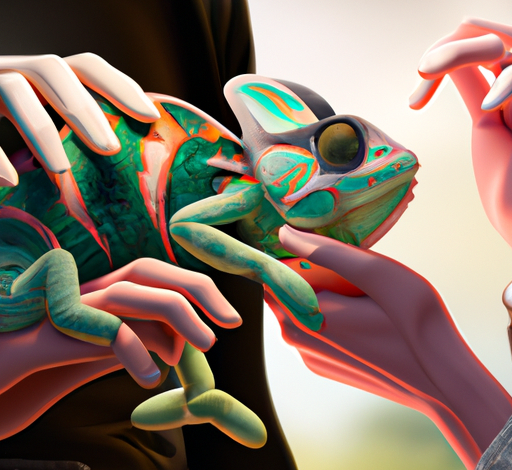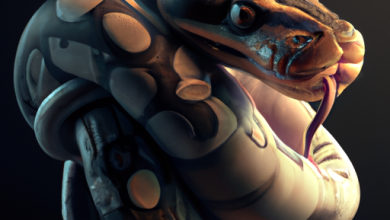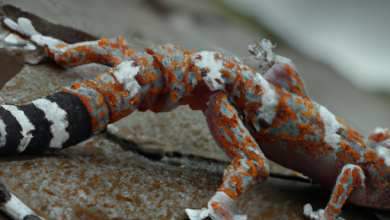How to Care for Pet Veiled Chameleons

Creating a Suitable Habitat for Pet Veiled Chameleons
Creating a suitable habitat for pet veiled chameleons is an important step in ensuring their health and well-being. Veiled chameleons are native to the Middle East and North Africa, and require an environment that closely mimics their natural habitat. The following steps should be taken to ensure that your pet veiled chameleon has a safe and comfortable home.
First, you will need to provide an appropriate enclosure. A terrarium or aquarium with a screened top is ideal, as it will provide good ventilation and prevent escape. The terrarium should be at least 18 inches tall, 24 inches long, and 18 inches wide. For an adult veiled chameleon, the terrarium should be larger, at least 36 inches tall, 48 inches long, and 24 inches wide.
Second, you will need to provide the right temperature and humidity. Veiled chameleons prefer temperatures between 70-85°F during the day and 65-75°F at night. The humidity should be kept between 50-70%. To maintain these levels, you can use a thermometer/hygrometer and a basking light or ceramic heat emitter.
Third, you will need to provide plenty of vegetation. Veiled chameleons are arboreal, meaning they prefer to live in trees. To simulate this environment, you can add artificial plants and vines to the terrarium. You can also add live plants, such as pothos
Feeding Pet Veiled Chameleons
Feeding pet veiled chameleons is an important part of their care. Proper nutrition is essential for the health and well-being of these animals. Veiled chameleons are insectivores, meaning they feed primarily on insects. A variety of feeder insects should be offered to ensure a balanced diet.
The most common feeder insects for veiled chameleons are crickets, mealworms, waxworms, and roaches. Crickets should be the staple of the diet, as they provide the most nutrition. Mealworms and waxworms should be offered in moderation, as they are high in fat and can lead to obesity in chameleons if fed too often. Roaches can also be offered, but should be gut-loaded with nutritious foods such as fruits and vegetables before being fed to the chameleon.
It is important to dust all feeder insects with a calcium supplement before feeding them to your chameleon. This will help ensure that your chameleon is receiving the necessary calcium for healthy bone growth. A multivitamin supplement should also be used once or twice a week to provide additional nutrition.
Veiled chameleons should be fed every day, with larger adults needing to be fed every other day. The number of insects offered should be appropriate for the size of your chameleon; a single adult should receive around 10-15 crickets a day, while a juvenile should receive around 5-10
Maintaining Proper Temperature and Humidity for Pet Veiled Chameleons
Maintaining proper temperature and humidity levels is essential for the health and well-being of pet veiled chameleons. These animals are native to the tropical rainforests of Yemen and Saudi Arabia, where temperatures are consistently warm and humid. In captivity, it is important to replicate these conditions as closely as possible to ensure that the chameleons remain healthy and comfortable.
Temperature is one of the most important factors for keeping pet veiled chameleons. The ideal temperature range for these animals is between 75-85°F (24-29°C). It is important to provide a thermal gradient, or a range of temperatures, within the enclosure so that the chameleon can regulate its body temperature by moving from one end of the enclosure to the other Additionally, a basking light should be provided so that the chameleon can bask in the warmth necessary.
Hum is also an important factor for keeping pet veiled chameleons. The ideal humidity range for animals is between 50-70%. This can be achieved by misting the enclosure twice daily with a spray bottle filled with dechlorinated water. Additionally, a humidity gauge should be used monitor the humidity levels within enclosure
Finally, it important to provide adequate for pet veiled chameons. The enclosure should at least one screened side to allow for air circulation. Additionally, a fan can be used to keep the air moving and help
Handling and Interacting with Pet Veiled Chameleons
Handling and interacting with pet veiled chameleons is an important part one of these amazing reptiles. Properly handled, veiled chameleons can be a great source of companionship and entertainment.
When handling a veiled chameleon, it is important to be gentle and slow. These reptiles are fragile and easily frightened by sudden movements. It is best to approach them from the side or from behind so as not to startle them. When picking up a veiled chameleon, it is important to support its entire body, including its tail, as its tail can easily break if not supported.
When interacting with a veiled chameleon, it is important to remember that they are solitary creatures and do not like to be handled for long periods of time. It is best to interact with them for no more than a few minutes at a time. During this time, it is important to speak in a soft voice and move slowly and calmly.
It is also important to remember that veiled chameleons are very sensitive to their environment. It is important to keep their enclosure clean and free of any potential hazards. It is also important to keep their enclosure at the proper temperature and humidity levels for their species.
Overall, handling and interacting with pet veiled chameleons can be a rewarding experience for both the reptile and its owner. With patience and proper care, these amazing reptiles can make great companions.
Cleaning and Sanitizing the Habitat of Pet Veiled Chameleons
Cleaning and sanitizing the habitat of pet veiled chameleons is an important part of their overall care. Properly maintaining the habitat helps to ensure the health and well-being of the chameleon. It is clean and sanitize on a regular basis to eliminate any harmful bacteria or parasites that could be present.
The first step in cleaning and sanitizing the habitat is to remove all of the decorations, plants, and substrate from the enclosure. This should be done carefully to avoid disturbing the chameleon. Once everything has been removed, the enclosure should be thoroughly cleaned with a mild soap and warm water. Be sure to rinse the enclosure thoroughly to remove any soapy residue.
After cleaning, it is important to sanitize the enclosure. This can be done by using a mild bleach solution. The solution should be mixed in a ratio of 1 part bleach to 10 parts water. Once mixed, the solution should be sprayed onto all surfaces of the enclosure, including the walls, floor, and decorations. Allow the solution to sit for 10 minutes before rinsing with warm water.
Once the enclosure has been cleaned and sanitized, it is time to reassemble it. Place the substrate back into the enclosure and add any decorations or plants. Be sure to check for any signs of damage or decay before placing them back into the enclosure.
Finally, it is important to monitor the health of your pet
Excerpt
Veiled chameleons are a popular pet choice for reptile enthusiasts. To ensure their health and happiness, they should be housed in an enclosure with temperatures between 75-85°F and humidity levels of 50-60%. They should also be provided with a variety of live insects as their primary food source. Regular misting and weekly cage cleanings are also essential.




